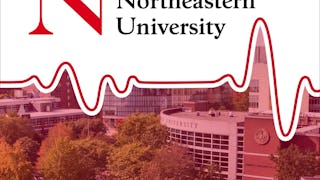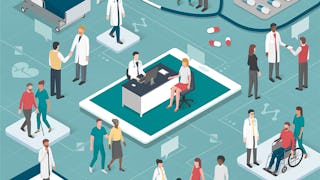This is the first part of a two part course on the U.S Healthcare System. This course will offer you an opportunity to examine concepts and topics related to understanding how the healthcare ecosystem works in the United States.
通过 Coursera Plus 解锁访问 10,000 多门课程。开始 7 天免费试用。


您将学到什么
Explain how the delivery of healthcare in the U.S. is organized and financed
Describe the major health care professions and current employment trends
Understand the connection between the historical foundation of American health care and its current state
您将获得的技能
要了解的详细信息
了解顶级公司的员工如何掌握热门技能

该课程共有4个模块
In this module, we explore the staggering amount of money that the U.S. spends on healthcare, currently over 4 trillion dollars annually, and how it has grown over the past 50 years. We will delve into where the money goes within the healthcare organization, and discuss the increasing importance of prescription medications in healthcare spending and debate the advantages and disadvantages of having a mixed structure of public and private funding. Over the last 50 years, healthcare spending in the U.S. has increased rapidly to almost $13,000 per person annually, with several factors driving this rise including demographics, advances in medical technology, and price inflation. Provider consolidation has been identified as a major source of concern contributing to higher prices, and there is much variation in prices across and within geographic regions of the country. We will explore the financing and spending in healthcare in greater detail throughout this module.
涵盖的内容
8个视频12篇阅读材料6个作业2个讨论话题
The healthcare provider landscape in the U.S. is vast and diverse, consisting of various institutions and professionals. Hospitals are a cornerstone of the healthcare system and employ a large portion of healthcare workers, but other institutions such as nursing homes and home health agencies are also crucial. In recent years, new types of institutional providers such as urgent care centers and retail clinics have entered the landscape promising to offer accessible and convenient care. In this module, we will explore the role of healthcare professionals in patient care and the growing diversity in the healthcare workforce.
涵盖的内容
3个视频4篇阅读材料4个作业1次同伴评审
The consolidation of hospitals in the U.S. healthcare system has been a steady trend for at least the last 30 years. This development has generated considerable debate as to its impact on healthcare delivery, particularly in terms of cost, accessibility, and quality of healthcare services. More recently, hospitals and physicians have been integrating, which constitutes another important development in the U.S. healthcare industry. We will also discuss the innovative delivery models that are used to enhance clinical care coordination among providers and examine trends in how healthcare providers and services are organized.
涵盖的内容
3个视频6篇阅读材料4个作业1个讨论话题
The entry of retail companies into healthcare is a clear sign of a deficit in the U.S. healthcare system - the oversight of the patient or the consumer. Consumers face many challenges, such as long waiting times, limited office hours, confusing care delivery, and abysmal coordination of care among different providers. With the opportunity to capitalize on a movement for consumer-centered healthcare, retail companies may be able to offer affordable, accessible, convenient, and respectful healthcare services to meet the challenge. However, their success in healthcare will likely depend on execution and commitment to the long haul.In this module, we will explore the potential benefits and drawbacks of these new healthcare entrants and what the future may hold for traditional healthcare providers. We will discuss the expanding decision-making role of consumers in regard to their healthcare choices and assess the growing opportunities for consumers to engage in self-care for their own health needs.
涵盖的内容
4个视频5篇阅读材料5个作业1次同伴评审
位教师

从 Healthcare Management 浏览更多内容
 状态:预览
状态:预览Northeastern University
 状态:免费试用
状态:免费试用Stanford University
 状态:免费试用
状态:免费试用University of Houston
人们为什么选择 Coursera 来帮助自己实现职业发展




常见问题
To access the course materials, assignments and to earn a Certificate, you will need to purchase the Certificate experience when you enroll in a course. You can try a Free Trial instead, or apply for Financial Aid. The course may offer 'Full Course, No Certificate' instead. This option lets you see all course materials, submit required assessments, and get a final grade. This also means that you will not be able to purchase a Certificate experience.
When you purchase a Certificate you get access to all course materials, including graded assignments. Upon completing the course, your electronic Certificate will be added to your Accomplishments page - from there, you can print your Certificate or add it to your LinkedIn profile.
Yes. In select learning programs, you can apply for financial aid or a scholarship if you can’t afford the enrollment fee. If fin aid or scholarship is available for your learning program selection, you’ll find a link to apply on the description page.
更多问题
提供助学金,
¹ 本课程的部分作业采用 AI 评分。对于这些作业,将根据 Coursera 隐私声明使用您的数据。





